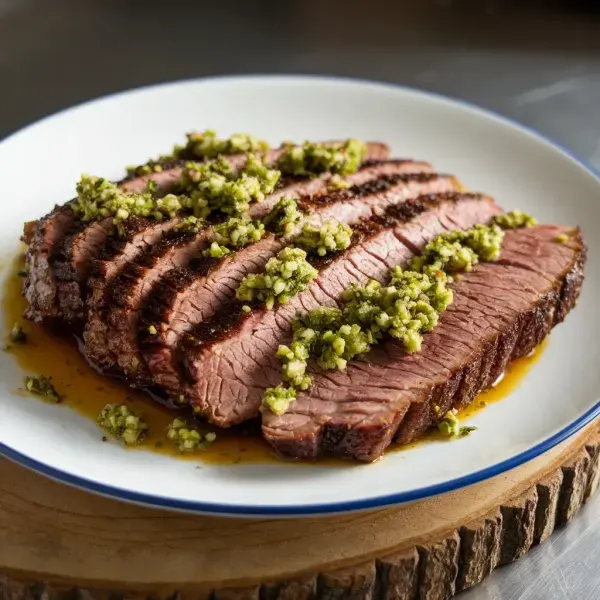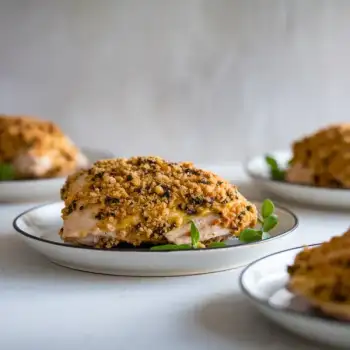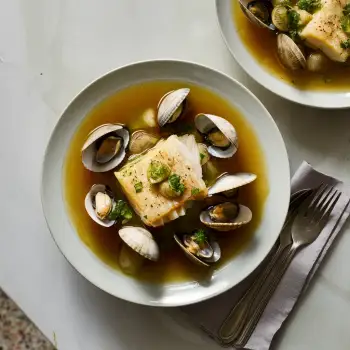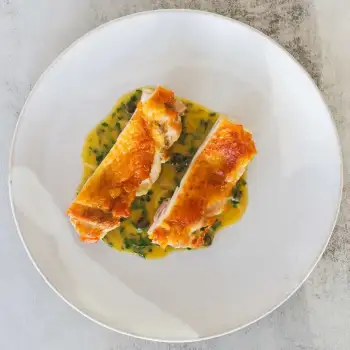
 240 minutes
240 minutesA succulent second-cut brisket with a golden-brown crust, accompanied by a zesty horseradish gremolata.


Second-Cut Brisket, massaged with spices and marinated overnight
0 lb
tablespoons
teaspoons
Garlic Clove, chopped
each
tablespoons
Onions, sliced
each
Carrots, sliced
each
Celery, sliced
each
cups
Bay Leaves, whole
each
Flat Leaf Parsley, coarsely chopped
Lemon Zest, from 1 small lemon, grated
Fresh Horseradish, coarsely grated
tablespoons
Flaky Sea Salt
pinches
1. Marinate the Brisket
Massage the brisket with kosher salt, black pepper, chopped garlic cloves, and fresh thyme. Cover and chill overnight. Before cooking, let the brisket sit at room temperature for 30 minutes and wipe off the excess seasoning with a paper towel.
2. Sear the Brisket
Heat a Dutch oven to a medium-high flame and add extra-virgin olive oil. Sear the brisket for about 4 to 5 minutes on each side until a golden-brown crust forms. Transfer the brisket to a plate.
3. Cook the Vegetables
In the same Dutch oven, lower the heat and add the sliced onions, carrots, and celery. Cook until they soften and turn slightly golden, about 15 minutes.
4. Deglaze with Wine
Pour in the dry red wine to deglaze the pot, scraping up any browned bits. Simmer for 5 minutes until the wine reduces slightly.
5. Bake the Brisket
Return the brisket to the Dutch oven with two whole bay leaves and bake in a preheated 325°F oven for 3 to 4 hours, turning every half hour. After 2.5 hours, remove the lid to allow the top to brown.
6. Refrigerate and Reheat
Allow the cooked brisket to cool, then refrigerate overnight for easier slicing and fat removal. Reheat in the oven before serving.
7. Thicken the Sauce
If needed, bring the sauce to a simmer in the Dutch oven on the stovetop until it reaches the desired consistency.
8. Make the Gremolata
Toss together the coarsely chopped parsley, grated lemon zest, and coarsely grated fresh horseradish in a bowl.
9. Serve
Slice the brisket against the grain, spoon the sauce over it, and sprinkle the gremolata on top along with a pinch of flaky sea salt.
Cooking the brisket low and slow (300°F/150°C) is crucial for tenderizing the tough fibers. A dutch oven is ideal for even heat distribution.
Opt for a whole brisket if possible or at least a flat cut with a nice layer of fat cap. The fat adds flavor and helps keep the meat moist during the long cooking process.
Enrich your braising liquid with aromatics such as onions, garlic, and herbs, along with a good quality stock or red wine. The brisket will absorb these flavors as it cooks.
Use fresh horseradish if available; it’s much more pungent than jarred versions. Fresh parsley and lemon zest add the necessary brightness to cut through the richness of the brisket.
Season your brisket generously with salt and sometimes a touch of sugar can enhance caramelization. Let it sit for at least 30 minutes before searing to draw the flavors in.




Comments (0)